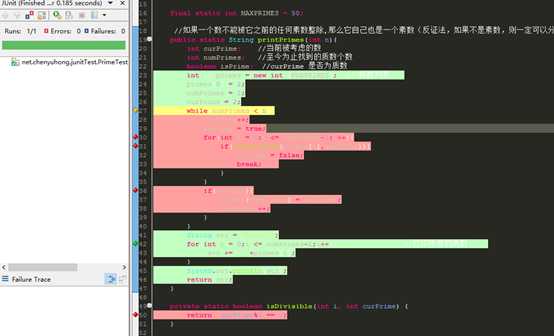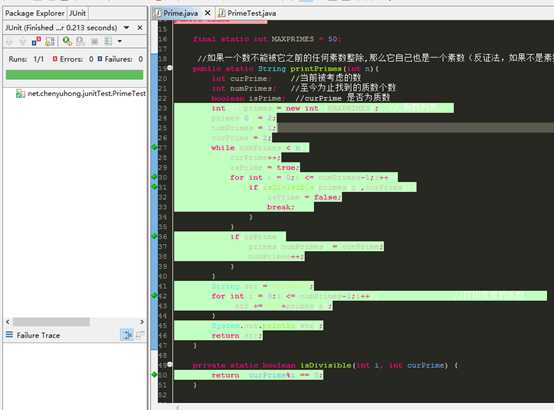标签:http his private ase pat integer org make node
Using the following method printPrimes() for questions a-f below
Prime.java
package net.chenyuhong.junitTest; import java.awt.datatransfer.StringSelection; import java.util.Scanner; /** * @Title: Prime.java * @Package net.chenyuhong.junitTest * @Description: 打印质数 * @author cyh tjuchenheng@163.com * @date 2017-3-12 下午6:23:11 * @version V1.0 */ public class Prime { final static int MAXPRIMES = 50; //如果一个数不能被它之前的任何素数整除,那么它自己也是一个素数(反证法,如果不是素数,则一定可以分解为若干素数的乘积,而这些素数一定比本身小) public static String printPrimes(int n){ int curPrime; //当前被考虑的数 int numPrimes; //至今为止找到的质数个数 boolean isPrime; //curPrime 是否为质数 int [] primes = new int [MAXPRIMES]; // 质数列表 primes[0] = 2; numPrimes = 1; curPrime = 2; while(numPrimes < n){ curPrime++; isPrime = true; for(int i = 0;i <= numPrimes-1;i++){ if(isDivisible(primes[i],curPrime)){ isPrime = false; break; } } if(isPrime){ primes[numPrimes] = curPrime; numPrimes++; } } String str = "Prime:"; for(int i = 0;i <= numPrimes-1;i++){ //打印所有的质数 str += "_"+primes[i]; } System.out.println(str); return str; } private static boolean isDivisible(int i, int curPrime) { return curPrime%i == 0; } // public static void main(String[] args) { //// //// Scanner in=new Scanner(System.in); //使用Scanner类定义对象 //// System.out.println("please input a integer number"); //// int n=in.nextInt(); //接收整型数据 // int i = 10; // while(i >= 0){ // printPrimes(i); // i--; // } // // // } }
PrimeTest.java
package net.chenyuhong.junitTest; import static org.junit.Assert.*; import java.util.Arrays; import java.util.Collection; import java.util.Scanner; import org.junit.Before; import org.junit.Test; import org.junit.runner.RunWith; import org.junit.runners.Parameterized; import org.junit.runners.Parameterized.Parameters; /** * @Title: PrimeTest.java * @Package net.chenyuhong.junitTest * @Description: * @author cyh tjuchenheng@163.com * @date 2017-3-12 下午8:43:08 * @version V1.0 */ @RunWith(Parameterized.class) public class PrimeTest { private String primeString; private int n; public PrimeTest(String primeString,int n){ this.primeString = primeString; this.n = n; } @Parameters public static Collection<Object[]> getData(){ return Arrays.asList(new Object[][]{ // // {"Prime:_2_3_5_7_11_13_17_19_23_29",10}, // {"Prime:_2_3_5_7_11_13_17_19_23",9}, // {"Prime:_2_3_5_7_11_13_17_19",8}, // {"Prime:_2_3_5_7_11_13_17",7}, // {"Prime:_2_3_5_7_11_13",6}, // {"Prime:_2_3_5_7_11",5}, // {"Prime:_2_3_5_7",4}, {"Prime:_2_3_5",3}, // {"Prime:_2_3",2}, // {"Prime:_2",1}, }); } @Test public void testPrintPrimes() { assertEquals(this.primeString,Prime.printPrimes(this.n)); } }
Answer:
■ (a) Draw the control flow graph for the printPrimes() method

■ (b)
Make sure the value of MAXPRIMES equals 4, then there will be an out-of-array –bound fault when n = 5;
■ (c)
Let the parameter n = 0 or n = 1.
■ (d)
TR for node coverage:
{1,2,3,4,5,6,7,8,9,10,11,12,13,14,15,16}
TR for edge coverage:
{(1,2),(2,3),(2,4),(3,5),(5,6),(5,7),(6,9)(6,8)(9,10),(10,5),(8,7),(7,11),(7,12),(11,13),(12,13),(13,2),(2,4),(4,15),(15,16),(16,4),(4,14)}
TR for prime path coverage:
{A(1,2,4,14),B(1,2,4,15,16),C(4,15,16,4),D(5,6,9,10,5),E(1,2,3,5,6,9,10),F(1,2,3,5,6,8,7,11,13),G(1,2,3,5,6,8,7,12,13),H(1,2,3,5,7,11,13),I(1,2,3,5,7,12,13),J(2,3,5,6,8,7,11,13,2),K(2,3,5,6,8,7,12,13,2),L(2,3,5,7,11,13,2),M(2,3,5,7,12,13,2)}
■ (e)
Using Junit and Eclemma to test the method and cover all prime paths above
1) Test Case : n = 1;
Test Path : [1,2,4,15,16,4,14]
Prime path covered: A,B,C

2) Test Case : n = 2;
Test Path : [1,2,3,5,6,9,10,5,7,11,13,2,4,15,16,4,14]
Prime path covered: A,B,C,D,E,H,I,L,M

3) Test Case : n = 3;
Test Path : ……
Prime path covered: A,B,C,D,E,F,G,H,I,J,K,L,M completely covered!

标签:http his private ase pat integer org make node
原文地址:http://www.cnblogs.com/--CYH--/p/6539658.html